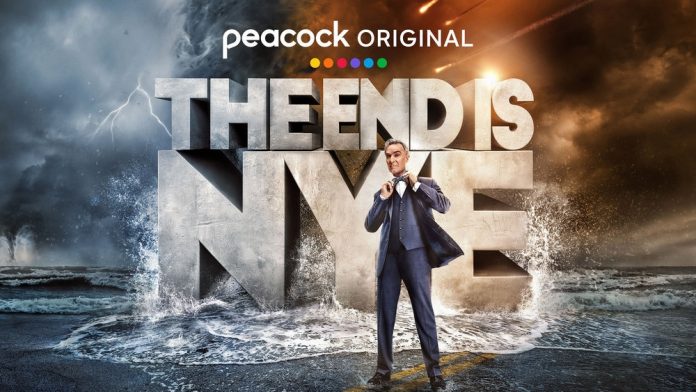Bill Nye is one of the most famous scientists on the planet and last year, he starred in a new documentary series titled The End is Nye that he co-created for Peacock along with The Orville duo Seth MacFarlane and Brannon Braga.
The End is Nye focuses on six different types of disasters — hydra storms, solar shockwaves, volcanos, dust storms, asteroids, and the Ring of Fire. The first part of each episode is presented as a disaster thriller, albeit one laced with comedy, which comes as no surprise given Nye’s co-creators.
As each episode progresses, Nye teaches us about science and explains how we can use it to mitigate the problems afflicting our world. Of course, in some instances, there’s really nothing we can do, especially if the sun releases a massive blast of solar waves. At that point, all we can do is hope and pray that the waves miss the planet.
Above the Line recently spoke to Nye, who discussed the genesis behind the project and how he and his cohorts found the appropriate balance of comedy and science-based terror. Yes, the series presents some scary scenarios, but MacFarlane, a science advocate who appears on camera in each episode, believes that media should scare people. That said, don’t be afraid to read on for more from Nye.
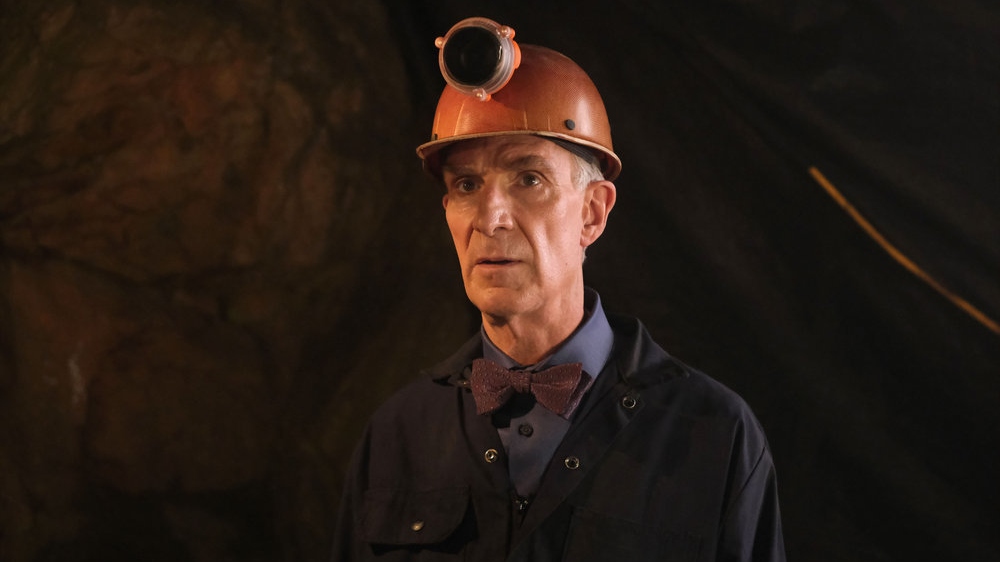
Above the Line: It’s so nice to meet you after growing up and watching you on TV for so many years.
Bill Nye: It’s really nice. Thank you. Where’d you grow up?
ATL: I grew up in Louisville. I’m now in Chicago, which may or may not be destroyed by a dust storm.
Nye: Well, it almost was once. Brannon Braga, my co-executive producer — he just really likes the Dustbowl story. I mean, it’s creepy, but he points out it was a human-made environmental disaster and we sure as heck could do it again. The way we’re going through water out west — oh my goodness.
ATL: Yeah. What was the genesis behind The End is Nye?
Nye: Well, [a] couple things. Let’s say Seth MacFarlane — do you know Brannon Braga?
ATL: I’m familiar. I did watch The Orville.
Nye: Yeah, yeah, there you go. Well, those guys work together all the time. They approached me [and said], ‘We ought to do something together.’ And then we got to talking and Seth MacFarlane remarked that a reason conservative media are so successful is that they scare people. ‘Conservative media scare people so we need to scare people.’ There’s much in what he says, and then from my point of view, science is going to be the key to how we get through these things. Scientific understanding — embracing the process of science — is how we’re gonna get through these disasters.
Brannon Braga is a big fan of disaster movies. He recounts, almost with tears in his eyes, [the scene] in The Towering Inferno when they asked for volunteers and everybody steps forward because everybody [is like], ‘We’re going to solve this problem.’ This discussion over the course of a couple of days led to the idea for the show — a disaster movie for the first half-hour [with an] optimistic view of the future addressing the things that caused the disaster with science.
ATL: I will say that I was caught off-guard when Seth MacFarlane first appeared in the show for the first time, as I guess I missed his “Created by” credit the first time around.
Nye: Yeah, yeah. He’s in every show. He’s good. He’s good at all of it.
ATL: I found it so terrifying and yet surprisingly, very humorous.
Nye: Well, we put jokes in it. I should have mentioned that earlier. I claim that in my family, humor was valued. Then you would say, “Well, what happened to you, Bill? You missed the point,” and so on. On the kid’s show, especially, humor is what keeps everybody engaged, not just the viewer, but [for] the people on camera — me and everybody — humor is important.
I’ll just tell you — whether it’s Tucker Carlson Tonight, The Late Show with Stephen Colbert, or The End is Nye with Bill Nye, it has to be an extension of that host. [Otherwise], it’s not going to work. Television, frankly, is too intimate. You can’t fake it and because it’s an extension of me, it has to be funny. At some point, it has to be funny. My dad was a prisoner of war for four years [during] World War II. I claim all the time [that] what helped him get through it was his sense of humor. My father was very funny so I’m glad you got some of the jokes.
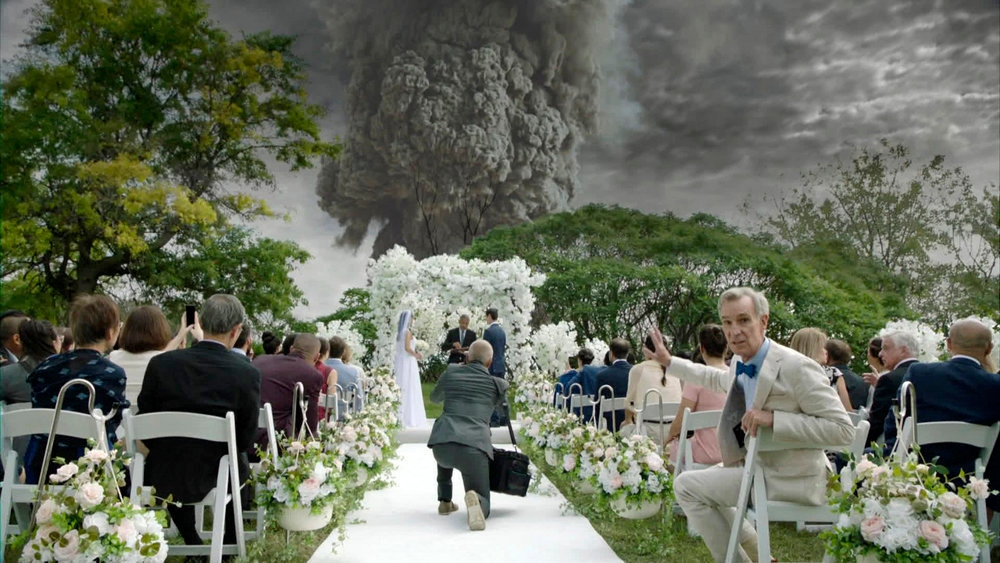
ATL: How did you all decide on the balance between comedy and terror, if that’s the right word?
Nye: Well, as writers, you find a rhythm. You don’t want to have too many jokes, but you don’t want to have too few. I guess that’s the dark art of writing a show like that — [finding] the balance between serious presentation of the material and the occasional hilarious comedy. “Chicago, where everyone knows it’s windy.” Come on, that’s brilliant! Do you even get that joke from The Association? “Who’s tripping down the streets?” Do you even get that joke or is it lost on the younger viewer? My life’s been a waste. Okay.
ATL: I know Chicago is the Windy City.
Nye: That’s right.
ATL: It’s also the Second City but that’s another story for another day.
Nye: Yeah, well — speaking of Stephen Colbert, so many great people have come out — Tina Fey and all those guys have come out of Second City.
ATL: I loved how the show used science to teach audiences how we can mitigate these disasters and either prevent them from happening, or at least prevent them from becoming worse events than they are.
Nye: There you go.
ATL: With the climate crisis being what it is at the moment, how likely is it that we’ll see hydra storms forming?
Nye: Well, that’s a question I really don’t know the exact answer to. But this is clear, the longer we don’t take action — by we, it’s humankind — and continue to pour carbon dioxide and methane natural gas into the air, the more likely that scenario is and the sooner it’s likely. Climate science or weather is based on probability. You listen to weather [reports] where everybody talks about “80 percent chance of rain, 50 percent chance of rain.” Specific consequences of climate change are hard to predict when it comes to global storms. What is — by the way — predictable, [are] heat events — extreme heat events are apparently pretty predictable with modern computer models. The answer is, “Let’s get to work.” The answer to the question of when is it going to happen is, “Let’s keep it from happening.”
ATL: Yeah, I definitely would not want to be on a plane when it does.
Nye: Oh, yeah. You liked that sequence? That was cool.
ATL: Yeah.
Nye: Kwasi [Songui] — he’s a Canadian actor. He’s a good guy. Would you shut up?!?
ATL: I lost it while watching it.
Nye: He’s cool. He’s very funny.
ATL: I thought the Disaster Simulator set was very impressive, too.
Nye: That’s Brannon, man. We love Night Gallery. Are you of an age to have ever seen that show?
ATL: I’ve never seen it, but I’m familiar with the name because of an obscure filmmaker named Steven Spielberg. Ever heard of him?
Nye: Yeah, I know. He works quite a bit here in Los Angeles. He’s never had a chance to meet me but I hope he does get one. Anyway, Brannon was really charmed by the idea of the Disaster Institute, and Jeff Okun, the special effects guy, thought it was a cool thing. They made these really detailed pen and ink drawings of the Disaster Institute, and then Jeff and his crew created these greenscreen effects behind each archway. It was really cool. That was a really gratifying, fun thing to shoot.
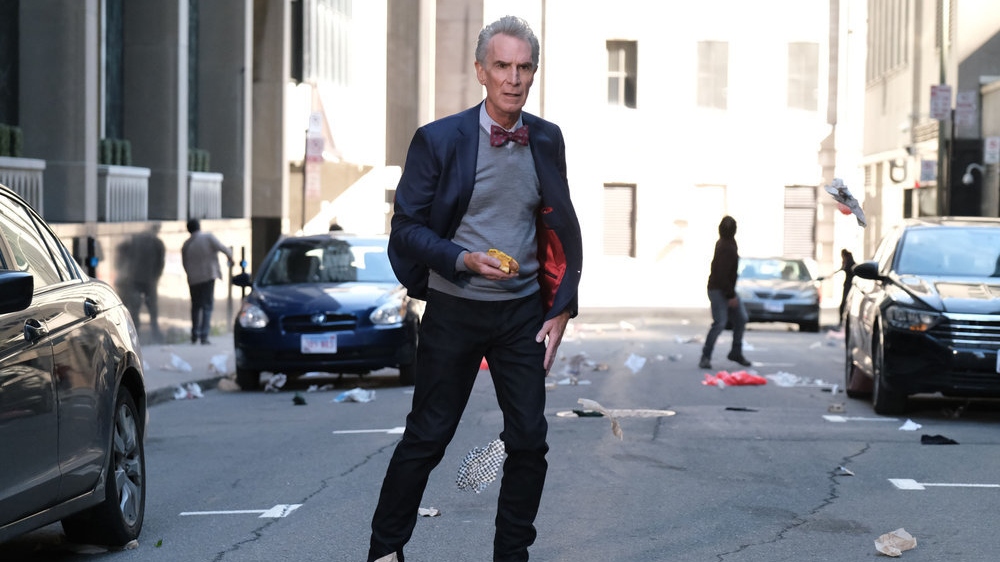
ATL: Was it always the plan to destroy it during the final episode?
Nye: No, but it certainly became a great idea. “Oh, yeah, that’s what we ought to do, destroy the Disaster — let’s go, people, come on, let’s blow it up,” which we did, digitally.
ATL: How much of the series was filmed on location rather than a soundstage or backlot?
Nye: Well, it depends. We shot the cornfield north of Montreal, but a crew did go to Yellowstone and a crew did go to Ashfall, Nebraska [to] get some background footage [and] B roll. Most of it was shot in Montreal.
ATL: Do you think we’ll see a Yellowstone eruption anytime soon?
Nye: No. But if it were to happen, it would be a catastrophe. The other thing to appreciate is not just Yellowstone and the supervolcano, but many, many cities and villages, and farm arrangement [and] farm agricultural systems, are set up near or downwind of volcanoes, because of this thing that we call the volcano paradox, where these nutrients that plants need come out of volcanic ash — potassium phosphorus, for example. The paradox is [that] volcanoes will kill you, but wait, volcanoes enable you to eat. [So] you need them, you need volcanoes.
And now, it’s becoming clear, in that example, [that] the movement of tectonic plates not only produces volcanoes, which lead to soils with nutrients for farm plants, but that the tectonic plates probably wouldn’t be sliding around as much as they are if it weren’t for things living on them. The blue-green algae make the tectonic plates more slippery and it’s really quite an insight.
Once again, it’s another thing humans have come to realize by studying Mars. Mars is smaller… and if it does have tectonic movement, it’s not pronounced the way it is on Earth. It’s almost non-existent and along that line, there’s nothing living that we’ve observed on Mars. Like, the living things on Earth enabled tectonic movement. Tectonic movement enables living things. If you don’t have it, you end up with this lifeless desert that you have on Mars.
ATL: What has the reaction been like since the series was released last August?
Nye: Well, it’s been great. We are very hopeful that we get an Emmy nomination — I mean, I don’t know, it’s not up to me, but we feel we did a really good job and the viewership has been good and we’re trying to change the world.
ATL: Which came first — the interest in comedy or science?
Nye: Oh, science — [it’s] way, way, way more influential. I say all the time that I was stung by a bee when I think I was not yet in kindergarten. I might have been four years old, stung by a bee, and it freaked me out. I was crying, I was miserable. My mom put ammonia on the wound, on the swelling part of my leg — I was wearing shorts — and it started to feel better. Somehow, the ammonia denatures the bee venom [and] somehow breaks it down. But the ammonia bottle has a skull and crossbones on it, like, “my mother is trying to kill me,” which I can understand. I was a high-energy, little boy, but that was amazing to me.
Not long after that, I was able to read well enough. I saw in the Washington Post on Sundays, Ripley’s Believe It or Not, and according to aerodynamic theory, bees cannot fly. I remember even as a kid going, “Wait, the bees are flying. There’s something wrong with your theory.” Indeed, bee flight was not fully understood til 30 years ago, when high-speed photography and the so-called Computational Fluid Dynamics [were] able to mathematically analyze these whirlpools in the air around bee wings. [It’s] really amazing.
Science came way before comedy but I always liked comedy. I mean, who doesn’t like funny things? My goodness.
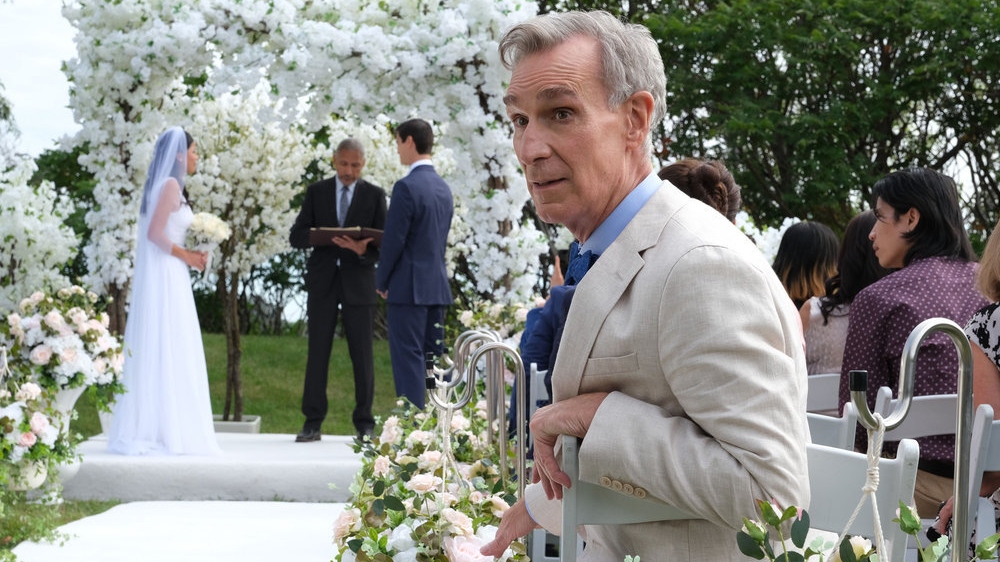
ATL: Was there a Professor Proton that inspired you?
Nye: Well, I had Mr. Wizard. I’m of a certain age, [and] Don Herbert had a show, to my recollection, originally on CBS, and then he ended up reproducing most of his demonstrations on Mr. Wizard’s World on Nickelodeon. I was awarded the Science Educator Award by the National Science Teachers Association, the elementary version of that. That was quite a thing because I had lunch with Don Herbert. It’s really something. His wife told me that Don was very happy to have someone to whom he could pass the torch. I really got choked up, that was quite something.
Don Herbert was just a master of science demonstrations. He did this thing with balloons and a bottle and a candle, and it was cool — or a match. It was cool. [So] I had Don Herbert, and then in engineering school, I had Carl Sagan for one class and it changed my life. Critical thinking was his whole thing and now I’m CEO of the Planetary Society, which he started. He was a co-founder of the Planetary Society. I’m a charter member and now I’m CEO. [So] these people have been hugely influential.
I got into Cornell engineering school because I had a great physics teacher. I did well in his course because I had a great seventh-grade science teacher and a great sixth-grade teacher, in my opinion, and my algebra teacher was good.
ATL: Going back to disaster movies for a moment, which of those films is the most realistic?
Nye: Well, they’re all realistic. We hired real scientists to do real analyses of real things that could really go wrong. The comet impact may be extraordinary because we only give you a year, and then 11 days, a million seconds to deflect it.
If you like to worry about things, the one that’s really worthy of worrying about is the coronal mass ejection, where the sun produces these huge magnetic fields — these particles streaming toward the Earth — that turn off all the lights, that short circuit our electrical grid. This happened, I’m going to say from memory, [in] 2012. There was a coronal mass ejection stream of particles that missed the Earth by about two weeks. It hit the Earth’s orbit two weeks behind us.
The other infamous event was [in] 1859, the Kerrigan event, where the solar flares caused fires in telegraph offices. This is when there were just a few telegraph wires run all over the place. But now, there’re wires running everywhere and they interact with the Earth and a giant antenna. In the same way they had two events in 1859, if we had two coronal mass ejections 12 hours apart, you turn off the lights all over the Earth. You couldn’t turn them back on because the transformer factories that you need to make new transformers are also ruined. If you like to worry about something, that’s a good one.
ATL: Yeah. I try not to worry about them but there’s some part of me that’s like…
Nye: We all do! We all worry!
ATL: There are times when my headspace is like, I can only watch these disaster thrillers like Deep Impact or Volcano or Dante’s Peak, etc.
Nye: Yeah, we all love disaster movies for some reason. It’s deep within us.
ATL: Yeah. I don’t know. I’m not sure if it’s watching someone else having a worse day than I am, or what.
Nye: Well, you’re trying to figure out what you could do, I think. It’s why you watch sports. It’s like, “If I were in there, man…” or “If I were managing that team, I would put so and so in there. Why don’t they listen to me?” and so on.
ATL: It’s been a pleasure getting to chat with you this afternoon.
Nye: Thank you very much, Danielle. It’s been fun. Let’s change the world!
All episodes of The End Is Nye are currently streaming on Peacock.


